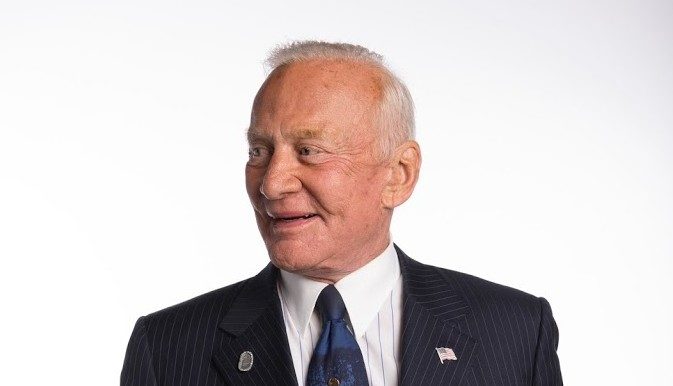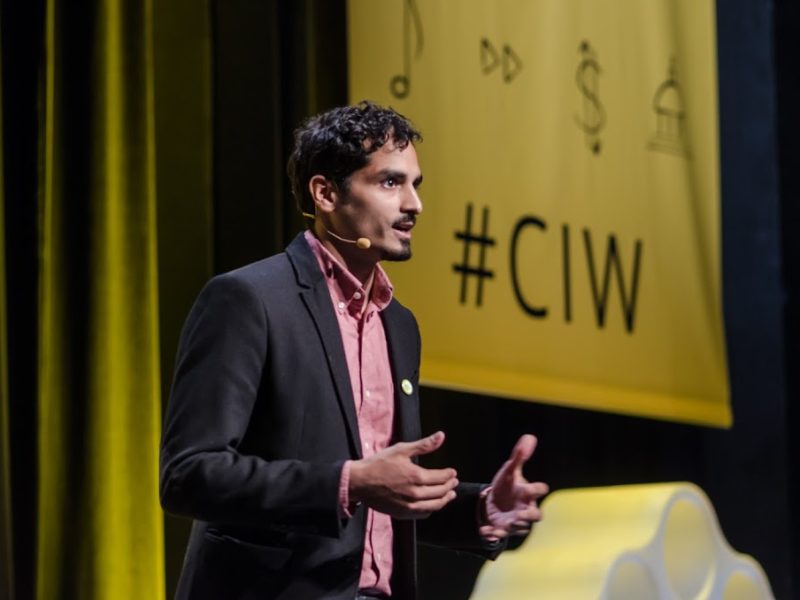
CIW Talks Solutions at Environment: Conserve and Protect
 |
| Environment gurus answer audience questions during Chicago Ideas Week. |
Chicago Ideas Week (CIW) speaker Peter Byck, a filmmaker and professor at Arizona State University’s School of Sustainability and Cronkite School of Journalism, had extra motivation while filming Carbon Nation, a 2010 documentary about solutions to lowering the global carbon footprint: His Uncle Phil.
Byck said his uncle was constantly sending him articles trying to prove that global warming was a myth, and Byck said he realized he couldn’t convince his uncle otherwise. Instead, Byck asked his uncle what he thought about our soil, water and air – and it turned out they agreed that the way we manage those natural resources needed to change.
Byck was one of three speakers sharing his story to a packed Edlis Neeson Theater at the Museum of Contemporary Art on Oct. 19 as part of CIW’s Environment: Conserve and Protect Talk. The event was one of about 25 major Talks taking place throughout the weeklong innovation festival Oct. 14 – 20.
Byck encouraged attendees to approach the Uncle Phils in their own life to discuss the mismanagement of natural resources instead of debating about the existence global warming. adding that more often than not they will agree. Byck said they’d find the country is not as polarized on the environment as it seems, and likeminded people could work together to bring about real-world, clean energy solutions.
“(Ask them) ‘What do you think?’” Byck said, telling guests to prod about solar power and clean air and water. “Have reasonable conversations and elect reasonable people.”
 |
| Speaker Vicki Arroyo, executive director of the Georgetown Climate Center. |
This strategy not only with his dad, he said, but also with a UPS pilot he sat next to on a flight. The pilot had seen Byck’s film, and while he didn’t say whether his view of global warming as a myth had changed, he did say that he now wanted to be a fuel-efficient pilot. In order for change like this to happen, Byck said people need to adopt the bottom-line attitude evident in his movie’s tag line: “A climate change solutions movie that doesn’t even care if you believe in climate change.”
Likewise, Anne Thompson, the Talk’s host and NBC’s chief environmental affairs correspondent, told the audience that discussion needs to revolve around how to deal with the faltering environment.
“Twelve of the last 15 years are the hottest reported since we began taking temperatures,” Thompson said. “One-fourth of all plants and animals could be extinct by the end of this century if temperatures keep increasing at their current rate. How is life going to change as the world heats up?”
Byck, along with speakers Vicki Arroyo, executive director of the Georgetown Climate Center that advocates for government climate change policies, and Heather Tallis, the first female lead scientist at The Nature Conservatory, discussed those problems – such as issues in storm behavior, soil and rainwater – and what can be done to solve them.
said he knows more than a few Uncle Phils – some of whom are even close friends. He said he was relieved to know that people can hold different political beliefs but still partake in environmentally sound practices.
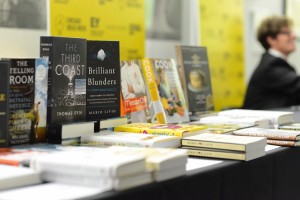 |
| Speakers sign their books at CIW’s Environment Talk. |
“I’m totally convinced that global warming is real,” Grevengoed said. “I tend to be a little bit argumentative and tend to like my own opinion too much, and it was nice to hear that people don’t have to agree with you on all that stuff.”
One thing most all Americans can agree on is that Hurricane Katrina was absolutely devastating. Arroyo, a native of New Orleans, said she knows this all too well.
While she wasn’t living in the Big Easy in 2005, she said relatives there needed to move in with her after the storm. Arroyo said Hurricane Katrina was a prime example of a string of “superstorms” that have been occurring in recent decades, like Superstorm Sandy that wreaked havoc on the eastern seaboard about a year ago.
“Global warming is basically fueling these storms,” she said. “It’s like climate change is steroids for storms.”
Arroyo devoted most of her speech to discussing a more controllable piece to the puzzle than the storms themselves – disaster relief. She said Hurricanes Katrina and Rita caused more than $100 billion of damage in the U.S., and reducing that number requires learning what went wrong with the infrastructure and investing in new damage control methods. Simply replacing the ineffective systems that broke down during the storms is not sound policy, she said, adding that backup generators should be moved to higher floors so that they can work during flooding.
Taking measures to prevent floods would be helpful too, Byck said, and healthy, carbon-rich soil could be one such counter measure in rural areas. The filmmaker said carbon levels in U.S. soil are low at just about 1 or 2 percent when they should be at 10 percent. Increased carbon in soil means the microorganisms living in it are healthy – which makes soil more absorbent and able to reduce storm water runoff.
“There are 70,000 different organisms alive in a handful of healthy soil,” Byck said. “When [it’s] alive, the soil is porous.”
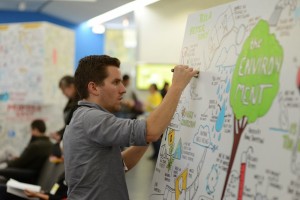 |
| Ink Factory’s Ryan Robinson captures the Talk with real-time graphic art. |
How that very rainwater becomes drinking water was something The Nature Conservatory’s Tallis dove into with the audience. She said the U.S. water treatment process is “like a Ponzi scheme.” Before we can drink water, it goes through an extensive treatment process funded by taxpayers. In 2007 alone, Tallis said we put $101 billion into our water treatment system – but the problem is that the water runs across farmland that is treated with chemicals. Therefore, the extensive purification system than citizens pay for doesn’t totally purify the water. Tallis said letting nature run its course would save money and result in higher quality water.
“We can invest to keep water clean at the source,” Tallis said. “The roots of plants and trees and soil itself act as filters.”
Tallis insisted nature could also help save the bee population, which has seen a decline in hives at a rate of 30 percent every year between 2007 and 2011. Backstage Tallis said one-third of U.S. crops need pollination to grow and that semitrucks are transporting scarce bees from farm to farm to help. Growing bee habitats around farms would bring the insects back and allow the wild pollinators – which Tallis said are more effective at their job than domesticated bees – to help cultivate crops and increase the diminished food supply.
Tallis said she hoped to show that conservationists like herself are trying to highlight issues that are “core to everything we rely on,” such as food, and not just problems that affect distant vacation spots. She said CIW is a terrific way to get across that message.
“It’s a great platform,” she said. “It brings together minds that don’t usually get to meet, and gives us a platform to engage the public – that is not common for scientists.”
Tallis and the other speakers took advantage of that engagement with a Q-and-A session towards the end of the event.
“Is global warming too big of a problem to fix?” someone asked.
Tallis said the science and tools are there for humanity to make the necessary changes, and Arroyo said we need to lower our fossil fuel emissions if there will be any recovery. Once the world does that, Byck said nature would kick in and do its part to stay healthy.
“I’m fully convinced that the natural system wants to be rocking,” he said.
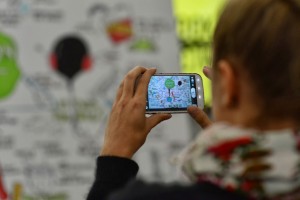 |
| An attendee snaps a photo of Ink Factory’s graphic art from the Talk |
Anne Salva, 50, said she wanted to attend the Talk because she believes the worsening environment is our planet’s biggest challenge. Salva, who works in construction management in Aurora, said it’s now her responsibility to spread the information, especially to her kids.
“People like us will come, but now I have to go home and tell everybody and go on Twitter and tell my kids,” Salva said. “When somebody comes up with some stupid ‘Uncle Phil’ statement, they’ll be armed with facts, ideas and questions to ask.”
Aaron Mittons, a 15-year-old enrolled at Chicago Tech Academy and a CIW YOU(th) empowerment program participant, said he was there because he is interested in studying energy consumption. Mittons said he enjoyed how each speaker’s presentation built upon the previous one and provided a fair medium to voice their thoughts.
“(CIW) encompasses something that you should do in your day-to-day life, which is seeing other people’s perspectives,” Mittons said. “It adds a lot to your personality and to you as an individual if you get to see other people’s views on things.”
*Check out www.chicagoideas.com in January to see full videos of the Talks each of our dynamic speakers gave!*
____________________________________
Written by: Doug Pitorak


